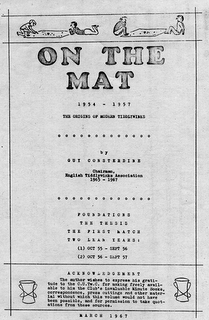They don't like us! They really don't like us!
For those of you who do not call on M2 Universal and thus might not have seen the annual report on the magazine industry published in the "Media Mix Outlook 2006" authored by Elizabeth Kan (now at Mediavest) and Melissa Williams, I present it here in full, with my comments in red. A warning - it isn't always pleasant reading. But then, isn't it their job to push the media?
Technology is redefining the consumer's relationship with media. Many traditional and emerging media enjoy great expectations and excitement over new opportunities to engage consumers in this brave, new world. In contrast, magazines suffer from the perception that they are stale, uninspired, and dull. To many, magazines have become nothing but an afterthought in the changing media environment. Surely with more than 1200 Canadian magazines, there must be a few that aren't dull. Like Rich Guy. How stale is that? Or how's about Canadian Wildlife? Grrrrrrrrrrr! Nothing uninspired there. And could anybody in their right mind actually label a Canadian history magazine called The Beaver dull? I don't think so.
In reality, figures show that magazines are holding their own in the key measures of circulation, readership, ad pages and revenue. Selection has improved with new launches - from the crop of shopping magazines in the last couple of years (LouLou and Wish) to the new celebrity weeklies (Weekly Scoop) that are just hitting the newsstands. The quality of magazines is also improving, with titles being refreshed, redesigned and renovated to stay consumer-relevant.
No, the magazine medium is certainly not dead. Phew! The fundamentals are there; but it could sure use an extreme makeover! Me first! The following are ideas, which publishers might take to heart if they truly wish to compete in this very complex marketplace:
- As an industry, magazines tend to be myopic and inward looking. Publishers seem to focus only on their own performance in the short term. They should stop chasing a bigger piece of the pie and look more to growing the industry by focusing on advertisers' needs. Clients are looking for customized, innovative solutions to address communication needs. Publishers leading the pack are the ones that are selling ideas, not just pages to meet tomorrow's sales budget. Just what they want - little magazines with big ideas. Actually, I've witnessed many an RFP requesting creative solutions only to see the buy go to a corporate packaged buy where the only good idea was an unbeatable package price. We spend countless hours developing concepts and mockups for naught.
- Product placement and content integration are happening routinely in many media. Cars, food products and fashion items are frequently seen in movies and television programs. Magazines, however, take great pride in the separation of advertising and editorial, which M2 Universal believes is an antiquated notion. But it's so quaint; having a magazine where readers trust that the writers and designers are free-thinking artists and not commercial whores. A recent sponsorship by Cadillac of a section in MacLean's magazine caused a great deal of ink in the industry press, questioning the degree of client input into the content of the section. How ridiculous; this was a shrewd media buy, nothing more. Publishers should give their readers more credit. They are savvy consumers who understand and appreciate this type of placement, when done properly, not hapless victims in need of protection from unscrupulous advertisers. It is possible to uphold editorial integrity and be advertiser friendly at the same time. I agree and you can read my thoughts on the issue here. Sponsored sections and features, labelled advertorials and, in the case of Canadian Geographic and Toronto Life, sponsored guides with front cover logos, do nothing to damage the integrity of the content. But I also see that advertisers are asking for more in the way of "content integration" which sounds vaguely coital to me. Magazines market themselves on the unique relationship between the reader and the book. Unless they can help advertisers leverage that emotional bond, this is nothing but a tired cliche.
- Magazines are a tactile medium, which is truly a differentiating factor in this digital age. Let's have some fun with that. We would like to see production-led innovations that provide advertisers with strategic options, while allowing readers to interact with the book beyond run-of-press pages. Most importantly, these innovations, like gatefolds, vertical half pages and belly bands/wraps, should not cost clients an arm and a leg. Sounds like it's time for a plant tour.
- It is absolutely key that magazines develop research, which breaks down readership in more detail. What is reader traffic by section; do people read front-to-back or back-to-front; what is time spent by section? Do customized purchases (e.g. gatefolds, wraps) garner reader attention commensurate to the rates charged? The PMB Reader Engagement Study planned for later this year will provide great insight by studying quality of readership, audience relationship with the book and how avidly it is read. Is any medium researched more? And where are media planners going to find the time to review all this data? And if they find that the back of the book is better read, will they ever actually request "position well rearward". I don't think so.
It is extremely frustrating to see magazines fade into the background when there is potential for so much more. It wasn't that long ago when magazines led the industry in creativity and innovative thinking.
- Our perennial favourite - how about sales reps that sell, not just take orders? Don't I wish. About the only order I ever get is "jump through the hoop!" Where are the media partners who listen to client needs and earn the business? We're leaving you countless unreturned messages and emails begging for meetings and information. HELLO!!! Why can't reps understand the seasonality of the client's business and planning cycle and make sales calls accordingly? This is my favourite - call during planning and "we're too busy"; call any other time and "we have no brief so there is no point in meeting". M2 Universal is asking for and expects sales reps and publishers that understand the advertiser's business, the strength of their own books and the power of their medium. So that must be my problem - I'm focusing on my book's weaknesses.
OUR ADVICE IS: TAKE SOME RISKS AND RECLAIM THAT POSITION. PLEASE GIVE US SOMETHING TO WRITE ABOUT IN OUTLOOK 2007. Don't advertisers love risks! They jump into new magazines like kids into a pool on a hot day. Maybe they would like a sponsorship proposal from Maclean's on a fresh, exciting new series of Mohammed cartoons. Yeah, that's the ticket!


